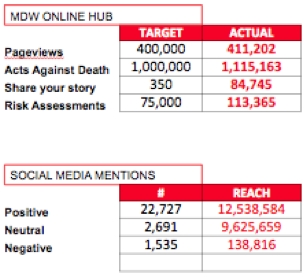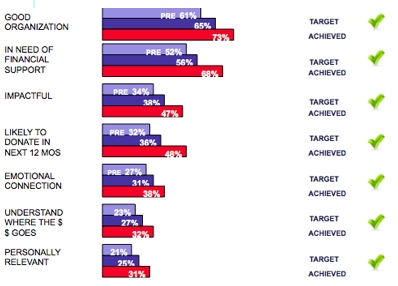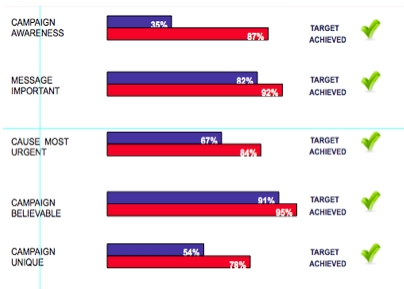Make Death Wait
Off to a Good Start (SILVER)
Client Credits: The Heart & Stroke Foundation of Canada
Director Parent Brand Marketing: Laura Plant
Sr. Manager, Parent Brand Marketing: Joanne Cullen
Former VP ; Marketing & Communications at Heart & Stroke Foundation of Canada: Lisa Chicules
Campaign Lead: Kelly McCarten
Director Of Digital And Direct Marketing For The Heart & Stroke Foundation Ontario: Kristian Dart
Agency Credits: Lowe Roche
Creative Directors: Geoffrey Roche, Steph Mackie, Mark Biernacki
Account Services: Dave Carey
Art Director: Steph Mackie
Copywriter: Mark Biernacki
Print Producer: Beth Mackinnon
Crossover Notes:
All winning cases contain lessons that cross over from one case to another. David Rutherford has been identifying these as Crossover Notes since CASSIES 1997. The full set for CASSIES 2013 can be downloaded from the Case Library section at www.cassies.ca.
Crossover Note 10. Conventional Wisdom—should it be challenged?
Crossover Note 20. Emotional versus Rational.
Crossover Note 24. Tough Topics.
Crossover Note 32. Internal Marketing.
To see creative, click on the links that are embedded in the case.
Section I — BASIC INFORMATION
| Business Results Period (Consecutive Months): | October 2011- April 2012 |
| Start of Advertising/Communication Effort: | October 26th , 2011 |
| Base Period as a Benchmark: | October 2010- April 2011 |
Section II — SITUATION ANALYSIS
a) Overall Assessment
In 2011, the Heart & Stroke Foundation of Canada was faced with a serious problem: Canadians had lost sight of how heart disease and stroke could directly affect them. The perception was that heart disease and stroke only targeted overweight, aging white men. And yet in reality, women had become the fastest growing segment that was prone to heart disease and stroke. Canadians were dying – because they were not educated and properly informed.
To make matters worse, Canadians believed that heart disease and stroke were fully treatable with a few days in the hospital. Apathy had set in. As a result, the Heart & Stroke Foundation was losing relevancy, and familiarity with the foundation was dropping significantly, especially when compared to the Canadian Cancer Society and the Red Cross.
Complicating this necessary change was the Heart & Stroke’s Board of Directors – a conservative board that would need to be convinced to invest in an advertising campaign that would remind the audience of their own mortality.
We needed to stop Canadians in their path. We needed to demonstrate how close heart disease and stroke truly are. We needed to change an entire nation’s perspective. And we needed to convince a large, conservative board of directors to rally behind a chilling message. [Crossover Note 24]
No easy feat.
b) Resulting Business Objectives
Business objectives:
- To raise $1.87 million in donations
- To get 75,000 Canadians to take a risk assessment
Communication objectives:
- Increase awareness of the Heart & Stroke Foundation to 35%
- Ensure that the Heart and Stroke message was perceived as important – 82% target
- Ensure that the Heart and Stroke cause was perceived as urgent – 67% target
- Ensure that the our campaign was perceived as believable – 91% target
- Ensure that our campaign was perceived as unique – 54% target
Social Media Objectives:
To build positive brand image and relationships in social media and to connect with people on a more personal level.
c) Annual Media Budget
Over $5 million
d) Geographic Area
Canada
Section III — STRATEGIC THINKING
a) Analysis and Insight
Our insight was formed from the observation that people took heart disease and stroke much too lightly. Very few people thought that it could affect them. In reality, heart disease and stroke would take 1 in 3 Canadians before their time. And shockingly, heart disease and stroke had become the #1 killer of women in Canada, even over all cancer deaths combined.
So instead of talking about all the positive things that the organization was doing, our primary task was to make the disease relevant to Canadians – young and old, male and female. We had to make it personal. [Crossover Note 20]
We needed the population to understand that death is around the corner for some of us, but more importantly, death may be closer than we think. It was time for us to “Make Death Wait”.
Our target market was the “health focused baby boomer”:
They are: Active, busy, vigorous – representing the largest (24%) cohort of the Canadian population. They are also the most at risk for heart disease and stroke.
They believe: That they are 10-15 years younger than they are, and believe in living for today and enjoying life while they can.
Their donation habits: They have a connection to and support health-related charities.
b) Communication Strategy
We felt that armed with the statistics we would open the minds of Canadians and hit them over the head with the message that heart disease and stroke can affect everyone. To get this point across we took a 2×4 to the Board meeting and slammed it on the table to illustrate what needed to be done to wake up Canadians.
We knew that “Make Death Wait” would spark controversy internally and externally. But both Canada and the Heart and Stroke Foundation needed an action to rally behind. [Crossover Note 10]
From a media perspective, we concluded that TV needed to be the launching medium for this target. It’s an expressive medium that would allow Death to take on a personality and campaign tone that additional channels could then support.
Section IV — KEY EXECUTIONAL ELEMENTS
a)Media Used
TV, magazine, online, OOH, social media.
b)Creative Discussion
By personifying Death we created the feeling that death is within arm’s reach of everyday Canadians. No matter what they were doing with their lives at the time, Death was watching – even stalking – ready to take someone at any time.
Armed with the alarming statistics, we created work that informed Canadians about the realities of heart disease and stroke. We aired two 30-second television commercials shot from Death’s point of view as he hovered over Canadians in their daily lives. In one spot, we spoke directly to health-focused boomer women, warning them that heart disease and stroke is their #1 killer. In another, we warned all Canadians that heart disease and stroke would take 1 in 3 before their time.
c)Media Discussion
After years of fragmented and inconsistent messaging, the Heart & Stroke Foundation wanted to stem the decline in key brand metrics and consumer engagement through its first truly national campaign. Media was enlisted to generate and sustain awareness as well as start to build a connection with the target audience.
To build consumer engagement, our media partner Mindshare enlisted the strengths of several broadcast vendors to fuse the brand values of HSF with their own content to provide a more meaningful interaction with the consumer.
Four separate broadcast partners (2 English + 2 French) were enlisted to help connect Canadians emotionally to the Foundation by making the disease relatable. Behind the scenes all 4 broadcasters worked together as a combined consortium to leverage learning, production efficiencies and timelines to maximize cost savings for HSF.
- Leveraged celebrity talent to tell their own personal stories of heart and stroke disease – over 15 different celebrities (Arlene Dickenson, Cheryl Hickey, Steve and Chris, Les Docteurs etc.)
- Integrated into CBC’s Live Right Now for all Canadians to take action to live healthier lives.
- Integrated our message into the live New Year’s Eve performance with Cheryl Hickey and Rick Campanelli with over 30,000 people in attendance and millions watching on TV.
- Integrated content of heart healthy information on multiple TV shows (ET Canada, Les Docteurs, Les Lionnes, L’Union fait la force, Moment de vertier)
Digital media was also used to generate online traffic and promote content. This included:
- A microsite to manage all activation and be the program’s core publishing platform, and a dashboard recording the number of Canadians joining the cause, and total donations.
- Email to amplify our content and messaging to 250K HSF email addresses and their 11.6 million potential social connections
- Social Media content strategy used to amplify our content and messaging to 109K existing HSF social media followers and 10.3 million potential social connections
- Robust social media monitoring and moderation to enable response to any negative reaction to the campaign.
Section V — BUSINESS RESULTS
a) Sales/Share Results
The campaign goals were carefully determined by research companies. Even so, the results blew all the targets away, and re-energized the HSF. giving them a common goal that all the volunteers could rally around. [Crossover Note 32] Even the Board of Directors who challenged the campaign at the start now support it 100%, and have approved funds for Phase Two of the initiative.
Business Results:
- Over $2 million in donations to date, plus “intent to donate” in the next 12 months has increased by 36%
- 113,300 risk assessments have been conducted vs. the 75,000 target
Communication Results:
- Awareness – 35% target / 87% achieved
- Message is important – 82% target / 92% achieved
- Cause is urgent – 67% target / 84% achieved
- Campaign is believable – 91% target / 95% achieved
- Campaign is unique – 54% target / 78% achieved
Social Media Presence:



Emotional Connection:
The post-campaign tracking showed that over 50% of Canadians now rank the Heart and Stroke Foundation of Canada in the top 3 charities they are emotionally connected to.

Media Summary of Results
- Campaign Ubiquity: Media was aligned to our core target’s media consumption habits, and delivered a feeling of ubiquity with more than 953 million impressions, delivered in 17 weeks.
- Unprecedented Media Support: Television producers and personalities were strongly connected to the cause resulting in never-before-seen access to talent, content and news programming.
- Emotionally Connected With Canadians: Partner integrations in addition to brand sell created a platform that emotionally connected Canadians to the cause resulting in more than a 40% increase in campaign awareness versus ingoing objectives. Brand relevancy and emotional connection increased by over 20%.
- Strong Value-To-Investment Equation: Media investments were leveraged to deliver a 2:1 ratio of media value to investment. (This does not include all of the added value production behind the integrations.)
b) Consumption/ Usage Results
c) Other Pertinent Results
d) Return on Investment
Section VI — CAUSE & EFFECT BETWEEN ADVERTISING AND RESULTS
a)General Discussion
The “Make Death Wait” campaign was a bold step. Up against internal and external challenges, this campaign aligned everyone at the Heart and Stroke Foundation of Canada, and was highly successful in helping Canadians realize that they were ignoring a serious problem. As results show, relevancy to heart disease and stroke was restored, and once again Canadians are not only emotionally but also financially invested in the cause. Heart disease and stroke are no longer fading into obscurity – we have reignited awareness of the diseases, and the passion necessary to Make Death Wait.
No other variables were changed at the Heart and Stroke. The results are 100% attributed to the Make Death Wait Campaign.
b)Excluding Other Factors
Spending Levels:
See the overall statement above.
Pricing:
See the overall statement above.
Distribution Changes:
See the overall statement above.
Unusual Promotional Activity:
See the overall statement above.
Other Potential Causes:
See the overall statement above.